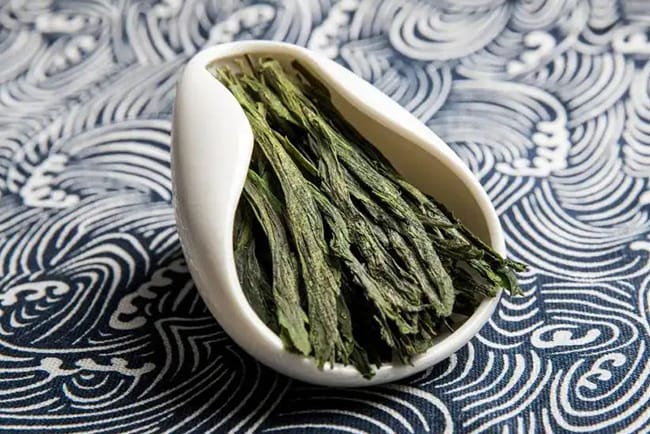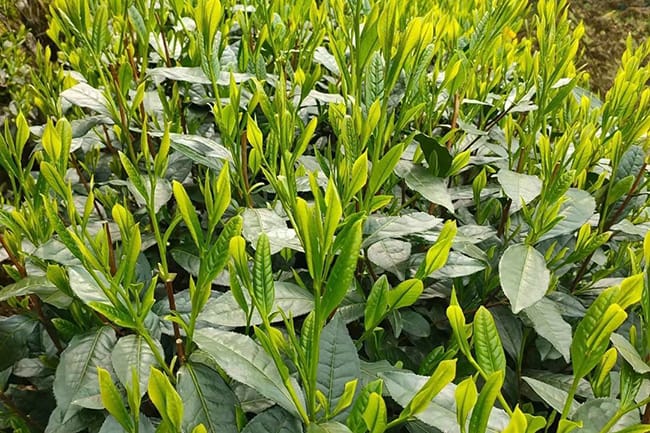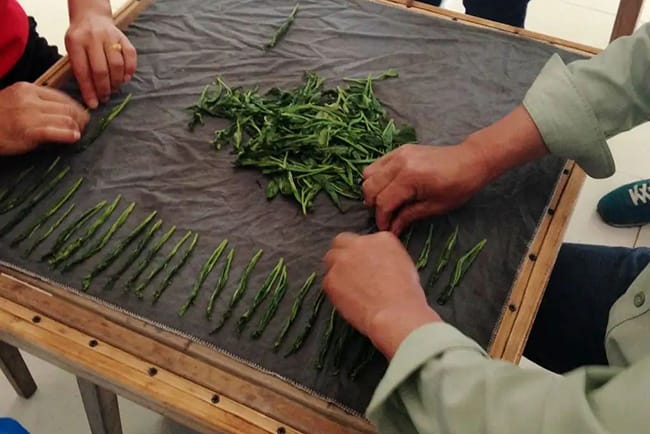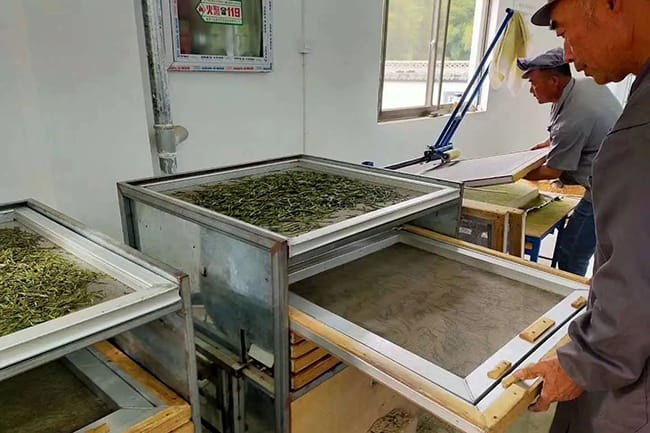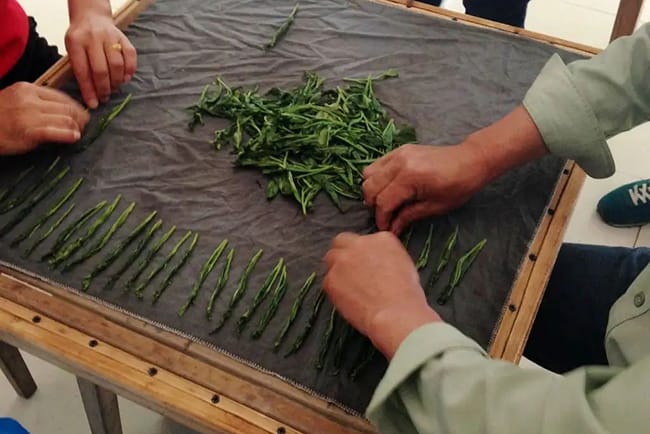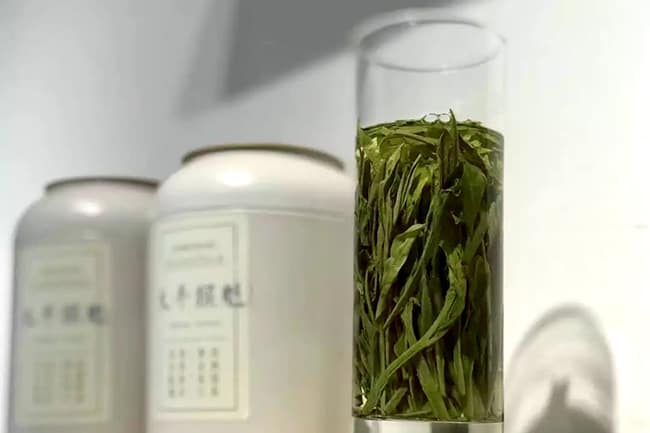Last Updated on 08/29/2023 by Desmond
Do you know any famous and expensive Chinese green tea? You may answer quickly – West Lake Longjing and Dongting Biluochun. But any else? Have you ever heard of Taiping Houkui tea? In the Chinese green tea lover groups, Taiping Houkui has a top status. It is also at a high price, especially the authentic ones.
CONTENT
What Is Taiping Houkui
Taiping Houkui belongs to the non-fermented green tea, origins in Taiping prefecture(current Huangshan Mountain district) Anhui province, China. Unlike common green teas, Taiping Houkui leaves are bigger, longer, and flatter. It looks similar to Lu’an Gua Pian tea, which originates in Anhui too, just flatter.
Name Meaning
Many guys translate Taiping Houkui into Monkey Chief tea. In fact, this is a mistake. Hou indeed means monkey, and Kui also refers to the chief in Chinese. However, the exact meaning of this name is the Best(Kui) Tea from the Hou Keng village, Taiping prefecture.
This mistake may stem from the old Guangdong and Fujian regions. In the past, some tea masters would train monkeys to pick the leaves grown on the cliff for making top-grade Oolong. And the tea is called Monkey Pick tea. Of course, no tea master does this now, no matter due to the cost or animal protection considering.
History
Taiping Kuijian is regarded as the predecessor of Taiping Houkui. It was invented by a tea master named Wang Kuicheng(1861-1909) in about 1900, who lived in Hou Gang village. And the tea was made from the one bud and to the second leaf.
In 1910, a Kuijian distributor from the Nanjing Changchun tea shop suggested bringing this tea to the exhibit for promotion. Thus, Fang Nanshan, Fang Xiangui, Wang Zhiwen(son of Wang Kuicheng), and Zhang Furong, 4 tea masters from Hou Keng village, refined processed out 2kg top-grade Kuijian tea, then they took the tea to the Nanyang Industrial Exposition for exhibiting. People love this tea much as tea masters expected. To not let people confuse the delicate leaves and the normal ones, they renamed it Taiping Houkui.
The highlight moment in this tea’s life as it took part in the Panama–Pacific International Exposition in 1915 and won the gold award. That made the tea famous worldwide. The pity is, Houkui tea took part in the exhibition as a representative tea of Anhui province but not like Keemun black tea use the exact name. And the gold medal was also lost later. So Taiping Houkui is often doubted whether it really won the honor, or just a marketing promotion.
However, the quality of Taiping Houkui is no doubt excellent. It was ever given as a national gift to Christine Lagarde(ex-managing director of IMF) and Vladimir Putin(President of Russia).
Origin
You may find that I mentioned two places above – Hou Gang and Hou Keng. I didn’t make any mistake, they are two villages quite nearby. With House Yan village, three are the Taiping Houkui core production regions located at Taiping prefecture(now Huangshan district.) Except for these three villages, the whole Huangshan district is the protective domain of geographic indications products regulated by the Chinese government. In other words, the Taiping Houkui from other regions is not authentic.
Huangshan district is located in subtropics, affected by monsoon subhumid climate, the relative humidity high to 80% and the annual average temperature at about 15℃. The mountains are foggy and rainy all year round, the sunshine duration is short, so the tea will not create a stronger bitter taste. Plus, the soil here is from the weathered metashale and is rich in mineral substances. All these things help cultivate top-grade tea trees.
The only drawback may be the inconvenient traffic here. All the core production villages are on the mountains, and the paths there are narrow and rugged. Hou Gang stays higher than Hou Keng, and you can only walk there. Maybe the folks remain the status intentionally so that they can keep Taiping Houkui more natural quality.
Why Taiping Houkui’s Leaves So Flat
You may be amazed by Taiping Houkui leaves’ unique look. It is flat, long(5-7cm), intact, and don’t curly, just looks like dried kelp. The impressive style of the leaves is because they are harvested from the unusual tea trees and processed in a unique way.
The Tea Tree Specie
The leaves for making Taiping Houkui are from a Camellia Sinensis named Shida Cha, which origins in Anhui. Unlike common tea plants, Shida Cha belongs to the big leaf species. Strong vitality, easy cultivation, and fast growth are its properties. While the bud bloom into the first leaf, the second leaf still clings to the bud. The tops of the three are at the same horizontal line. Tea masters used them to process Taiping Houkui and described them as “two machetes hugging a spear.”
Traditional Processing Method
Picking
The spring harvest of Taiping Houkui starts late, typically at about 10th April, waiting for the third leaf begins to expand. Tea masters pick the whole stem with three leaves and one bud on. The harvest will end at the beginning of May, and then the plants will only provide buds to make tip tea.
Placing
The picked leaves will be placed on a bamboo sieve for a while to let some water and the unlikable plant smell go away.
Sorting
To produce Taiping Houkui just need one bud to the second leaf, and their tops are best to be at the same horizontal line. So tea masters will sort all the leaves and remove the third leaf.
Fixating
Green tea belongs to non-fermented tea, so leaves should be fixated to stop from fermenting. Tea masters put the leaves in a pot at about 110℃, frying them with hands for 2-3 minutes. This will be a challenge. Leaves should not separate from the bud and get burned by the high temperature.
Shaping
The authentic Taiping Houkui, which is processed in a handmade way, is also called Nie Jian. Tea masters tenderly pinch every branch of leaves, which has been fixated, straight them and tight. This step costs most time and requires skills. Tea masters need to do it quickly because the leaves will soon be cold down and become hard to shape. Even the senior master costs about 10 seconds for processing one leaf. A tea master needs to work 14 hours to produce 1kg dried tea.
In the modern processing way, tea masters will shape the leaves under a small equipment help, and use another machine for pressing flat the leaves. Even so, it still costs a lot of time.
Drying
To dry the Taiping Houkui leaves needs a special multilayer drawer-type roaster. The bottom drawer is nearest to the fire and at a higher temperature. Leaves will be roasting in there for 2-3 minutes, then out for a break. At the same time, tea masters press the leaves with their hands or a small cloth pillow, making them flatter. And then they will be sent back to the higher drawer go on roasting. These steps repeat until the leaves’ water content reduces to about 5%.
Modern Processing Method
In a modern way, many machines will be used in Taiping Houkui bulk processing.
After tea masters straighten the leaves simply, they will be rolled into strips by auto equipment, then press flat by a machine. During roasting, leaves are stuck in the middle of two mesh screens so that they won’t cock because of the heating. Some tea masters also beat the screens with a duster to flatter the leaves.
Machines make the job easy(actually, it is still complicated and costs lots of time.) However, here comes a bigger problem. Excessive pressure and beating break the leaves, juice flow out and oxidation, affecting the leaves’ look and flavor. Worth knowing, Oolong tea is processed following this theory, and we call it semi-fermented tea. Besides, most Taiping Houkui leaves processed by machines look disunity, even distorted, and there are obvious grid patterns on the surface.
How Taiping Houkui Taste
There is also grading of Taiping Houkui. Leaves picked in the first flush and processed in ancient hand way will be the top grade as a matter of course. They are costly and all pre-ordered by powerful individuals, not for sale. Fortunately, the market-sold Taiping Houkui also has an excellent quality.
Taiping Houkui leaves are bigger and darker. There is some inconspicuous white fuzz on the bud hugged by two leaves. The infusion shows light apricot yellow, with a robust orchid aroma. Although it looks weak, it tastes smooth, mellow, and without obvious bitterness; it may benefit from the big leaf Camellia Sinensis’ properties. Besides, after the tea slip down your throat, there is still a fresh aftertaste and a lasting orchid aroma stay in your oral.
How To Prepare Taiping Houkui
To steep Taiping Houkui with a tall glass cup may be the best way; the leaves are really long.
- Rinse and preheat the glass cup(about 150ml) with hot water;
- Put 3-5g Taiping Houkui leaves in;
- Gently fill 85-90℃ water in the cup till to 1/3;
- Gently shake the cup for seconds, let the leaves get wet and soft;
- Go on filling hot water, then steep for about 2 minutes;
- Enjoy;
Do not finish the cup at one time; refill when 1/3 left. Typically, Taiping Houkui can make 3-4 brews. Worth knowing, when brewing Taiping Houkui with a glass cup, you can see the leaves expand and spin in the water slowly; tea lovers call it “Phoenix Dances,” and it looks really awesome.
It is also ok if you want to brew Taiping Houkui with a small teapot or a Gaiwan. Likewise, you need to fill moderate hot water to soften the leaves first, then push the outside leaves in the teapot gently, curving them, steep them in water, and then cover. Do all this as carefully as you can, try not to break the leaves. Yes, just like cooking spaghetti.
